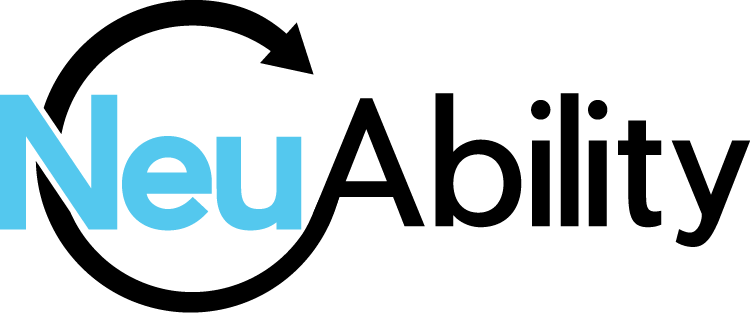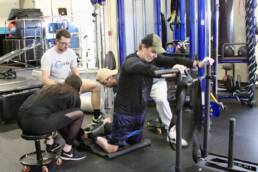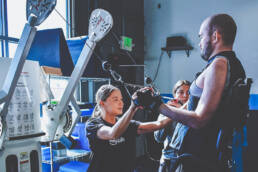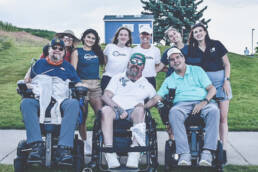When neurological injury strikes—whether from a spinal cord injury, stroke, or other form of paralysis—recovery often feels like an uphill battle. At NeuAbility, we believe in harnessing the science of motor learning and neuroplasticity to create meaningful, lasting change. Understanding how the brain and body learn to move again is the cornerstone of effective neurorehabilitation.
In this blog, we’ll break down the key principles of motor learning and show how NeuAbility applies them to empower individuals on their journey to independence.
Neuroplasticity: The Brain’s Ability to Rewire
What It Means
Neuroplasticity is the brain’s remarkable ability to adapt and reorganize itself after injury. It allows the nervous system to form new neural connections and relearn skills that may have been lost.
How NeuAbility Applies It
Our adaptive exercise and integrative therapies are designed to stimulate neuroplastic change. Every session provides a structured, evidence-based environment that encourages the nervous system to “re-learn” movement patterns through repetition, feedback, and goal-driven practice.
Practice Makes Progress—But Only With Purpose
Key Principle
Not all practice is equal. Deliberate, task-specific repetition leads to better motor recovery. The brain learns best when the activity is relevant, meaningful, and repeated consistently.
At NeuAbility
We tailor exercises to mirror real-life challenges—getting out of a chair, reaching for an object, or walking on uneven surfaces. These activities are broken down and practiced intentionally to promote skill transfer and real-world application.
Feedback is Fuel for Improvement
The Science
Motor learning thrives on feedback—both intrinsic (from within the body) and extrinsic (from therapists or equipment). This feedback helps correct movements and reinforce successful attempts.
NeuAbility’s Approach
Our team provides immediate and personalized feedback during sessions. We also use adaptive equipment and technology to give participants better sensory input, helping them adjust and refine their movements more accurately.
The Challenge Point: Finding the Sweet Spot
Why It Matters
The best learning happens when a task is challenging—but not overwhelming. This “optimal challenge point” ensures that participants stay engaged while steadily progressing.
Our Method
NeuAbility’s team is skilled in calibrating the right level of difficulty for each individual. We adjust the intensity, complexity, and support based on where each person is in their recovery, keeping the experience productive and motivating.
Variability Encourages Adaptability
Core Idea
While repetition is vital, mixing up the conditions under which a task is practiced helps the nervous system adapt. This is known as variable practice.
In Practice at NeuAbility
Instead of always practicing walking on the same surface, we might vary it—carpet, tile, inclines, or outdoors. This helps participants generalize their skills, preparing them for unpredictable real-life environments.
Motivation and Meaning Drive Engagement
The Insight
Motor learning is enhanced when tasks are emotionally meaningful and personally relevant. Motivation activates the reward pathways in the brain, making learning more effective.
How We Inspire
NeuAbility puts the person—not just the diagnosis—at the center of every session. We set personalized goals, celebrate milestones, and encourage participants to pursue activities they care about. Whether it’s dancing, hiking, or hugging a grandchild, we help bring those goals within reach.
Rest and Recovery Are Part of the Plan
The Science
Learning requires rest. Just like muscles, the brain consolidates information and skill development during periods of downtime.
What We Do
Our sessions are structured with the right balance of effort and recovery. We encourage quality sleep, stress management, and rest between sessions—knowing that healing doesn’t stop when the exercise ends.
Conclusion: Evidence-Based, Person-Centered Rehabilitation
At NeuAbility, we integrate the latest motor learning science into every aspect of our programming. We’re not just helping people move—we’re helping them thrive. By combining personalized care with cutting-edge neurorehabilitation principles, we give our participants the tools to write their own recovery stories.
Interested in learning how our programs can help you or a loved one? Contact us today to schedule a visit or tour our Denver facility. Let’s build new pathways—together.
Take the Next Step Toward Recovery
Whether you’re just beginning your journey or looking for new ways to push forward, NeuAbility is here to help. Contact us today or explore our programs to see how we can support your path to greater independence, strength, and community.
Like this article? Spread the word!
Related Posts
May 15, 2025
Begin Your Journey to Independence With Adaptive Movement in Denver
Discover NeuAbility, Denver's premier wellness center providing adaptive fitness programs…
May 9, 2025
Activity-Based Therapy for Paralysis: Building Strength, Independence, and Community
Learn how activity-based therapy (ABT) helps individuals with paralysis improve motor…
May 9, 2025
Exploring Adaptive Sports: Opportunities for Recreation and Recovery for Individuals with Disabilities
Discover adaptive sports like wheelchair basketball, hand cycling, and skiing—plus…





